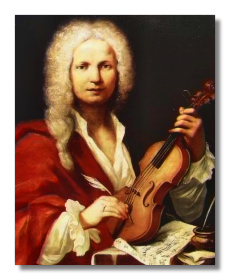 |
| Vivaldi |
Composer: Antonio Vivaldi (1678-1741)
Title: "Summer" Four Seasons
Movements: "Summer" (L'estate)
Date: 1723
Antonio Vivaldi, known as the "Red Priest", composed this set of violin concertos in 1723. They are one of the earliest examples of program music; that is, instrumental music that evokes or implies a person, place, thing, or story - all without singing or speaking. Inspired by four sonnets, which some believe Vivaldi may have written himself, each of these concertos musically conveys the sounds, sensations and impressions of the four seasons.
For our purposes, we will focus on Concerto No. 2, "Summer", or "L'estate" (click here for pronunciation). It is written in three movements (think of them as sections, but as an inseparable part of a whole, like the chapters of a book).
While listening to this work, read the sonnet below and try to visualize the scene:
I. Allegro non molto ("Fast, but not too much" - this movement actually starts slowly)
Under a hard Season, fired up by the Sun
Languishes man, languishes the flock and burns the pine
We hear the cuckoo's voice; then sweet songs of the turtledove and finch are heard.
Soft breezes stir the air... but threatening north wind sweeps them suddenly aside.
The shepherd trembles, fearing violent storms and his fate.
II. Adagio e piano - Presto e forte
(Slow and soft - Fast and loud)
The fear of lightning and fierce thunder
Robs his tired limbs of rest
As gnats and flies buzz furiously around.
III. Presto (Fast)
Alas, his fears were justified
The Heavens thunders and roar and with hail
Cuts the head off the wheat and damages the grain.
Another excellent resource we have on campus through the Rita Benton Music Library is the Naxos Video Library. I found this video about Venice and Vivaldi: An Armchair Guide to Classical Music. You can watch the entire thing, or jump to Part 6 and start at 14:00 to about 26:00. It tells a bit about Vivaldi's workplace, Venice, and his music.
ReplyDeletehttp://uiowa.naxosvideolibrary.com/title/BHDVD709/